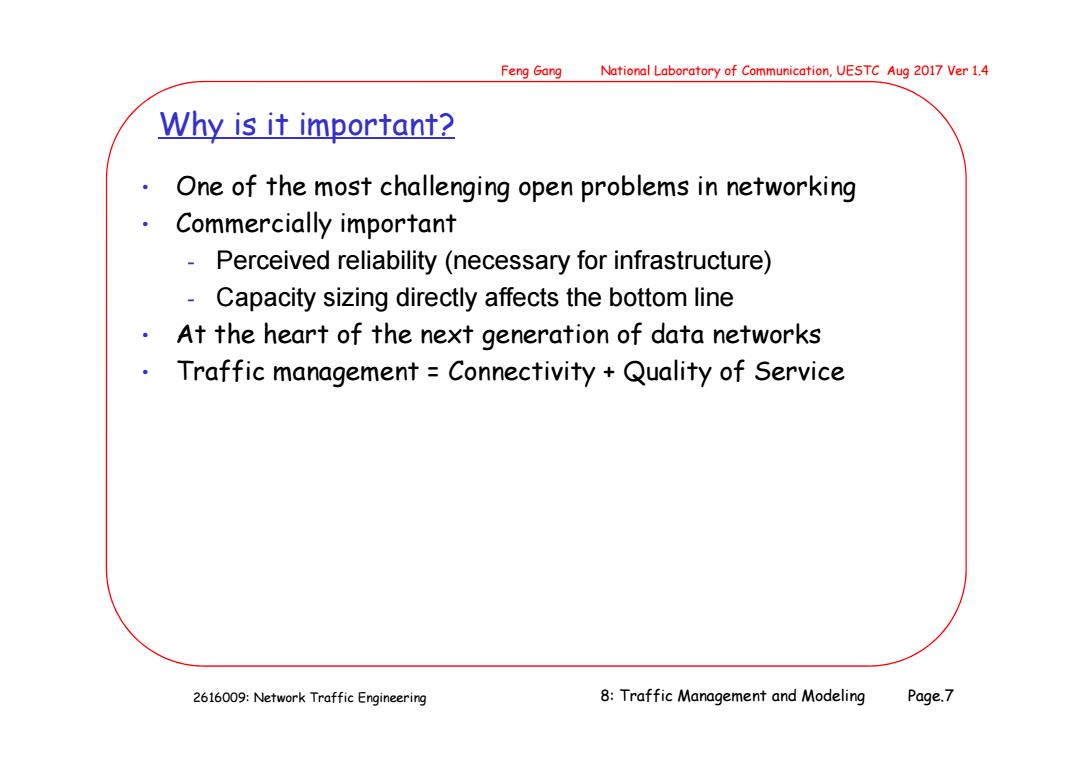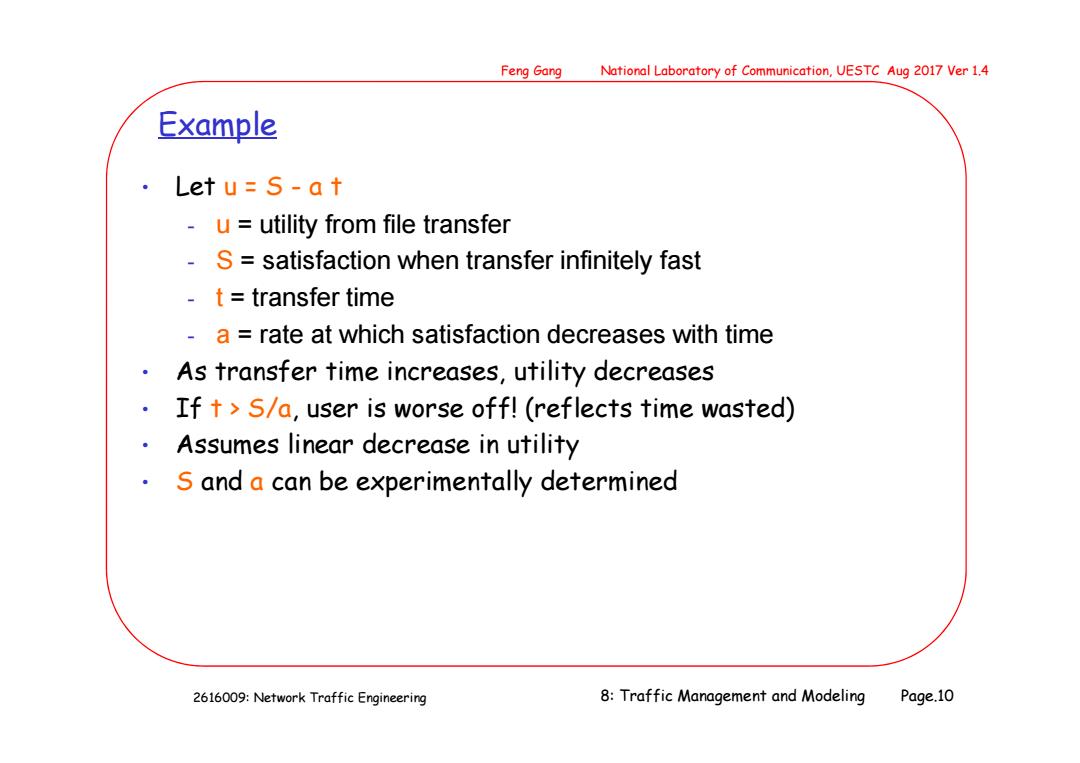
Feng Gang National Laboratory of Communication,UESTC Aug 2017 Ver 1.4 Traffic management Set of policies and mechanisms that allow a network to efficiently satisfy a diverse range of service requests Tension is between diversity and efficiency 。 Traffic management is necessary for providing Quality of Service (QoS) Subsumes congestion control (congestion =loss of efficiency) 2616009:Network Traffic Engineering 8:Traffic Management and Modeling Page.6
2616009: Network Traffic Engineering Feng Gang National Laboratory of Communication, UESTC Aug 2017 Ver 1.4 8: Traffic Management and Modeling Page.6 Traffic management • Set of policies and mechanisms that allow a network to efficiently satisfy a diverse range of service requests • Tension is between diversity and efficiency • Traffic management is necessary for providing Quality of Service (QoS) - Subsumes congestion control (congestion == loss of efficiency)

Feng Gang National Laboratory of Communication,UESTC Aug 2017 Ver 1.4 Why is it important? One of the most challenging open problems in networking Commercially important Perceived reliability(necessary for infrastructure) Capacity sizing directly affects the bottom line At the heart of the next generation of data networks Traffic management Connectivity Quality of Service 2616009:Network Traffic Engineering 8:Traffic Management and Modeling Page.7
2616009: Network Traffic Engineering Feng Gang National Laboratory of Communication, UESTC Aug 2017 Ver 1.4 8: Traffic Management and Modeling Page.7 Why is it important? • One of the most challenging open problems in networking • Commercially important - Perceived reliability (necessary for infrastructure) - Capacity sizing directly affects the bottom line • At the heart of the next generation of data networks • Traffic management = Connectivity + Quality of Service

Feng Gang National Laboratory of Communication,UESTC Aug 2017 Ver 1.4 Outline Introduction Economic principles 。 Traffic classes ·Time scales ·Mechanisms Some open problems on traffic management Traffic modeling-----self-similar traffic 2616009:Network Traffic Engineering 8:Traffic Management and Modeling Page.8
2616009: Network Traffic Engineering Feng Gang National Laboratory of Communication, UESTC Aug 2017 Ver 1.4 8: Traffic Management and Modeling Page.8 Outline • Introduction • Economic principles • Traffic classes • Time scales • Mechanisms • Some open problems on traffic management • Traffic modeling-----self-similar traffic

Feng Gang National Laboratory of Communication,UESTC Aug 2017 Ver 1.4 Basics:utility function Users are assumed to have a utility function that maps from a given quality of service to a level of satisfaction,or utility Utility functions are private information Cannot compare utility functions between users Rational users take actions that maximize their utility Can determine utility function by observing preferences 2616009:Network Traffic Engineering 8:Traffic Management and Modeling Page.9
2616009: Network Traffic Engineering Feng Gang National Laboratory of Communication, UESTC Aug 2017 Ver 1.4 8: Traffic Management and Modeling Page.9 Basics: utility function • Users are assumed to have a utility function that maps from a given quality of service to a level of satisfaction, or utility - Utility functions are private information - Cannot compare utility functions between users • Rational users take actions that maximize their utility • Can determine utility function by observing preferences

Feng Gang National Laboratory of Communication,UESTC Aug 2017 Ver 1.4 Example ·Letu=S-at u utility from file transfer -S satisfaction when transfer infinitely fast t=transfer time a rate at which satisfaction decreases with time As transfer time increases,utility decreases If t>S/a,user is worse off!(reflects time wasted) Assumes linear decrease in utility S and a can be experimentally determined 2616009:Network Traffic Engineering 8:Traffic Management and Modeling Page.10
2616009: Network Traffic Engineering Feng Gang National Laboratory of Communication, UESTC Aug 2017 Ver 1.4 8: Traffic Management and Modeling Page.10 Example • Let u = S - a t - u = utility from file transfer - S = satisfaction when transfer infinitely fast - t = transfer time - a = rate at which satisfaction decreases with time • As transfer time increases, utility decreases • If t > S/a, user is worse off! (reflects time wasted) • Assumes linear decrease in utility • S and a can be experimentally determined